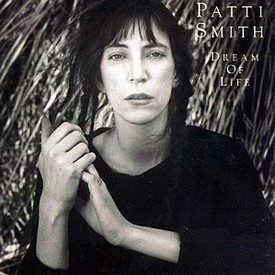By Umut NewburyÂ
February 23, 2009
Â
 “Life isn’t some vertical or horizontal line; it isn’t neat,†declares Patti Smith early on during Dream of Life. This is true for both the subject and the style of Steven Sebring’s documentary.Â
“Life isn’t some vertical or horizontal line; it isn’t neat,†declares Patti Smith early on during Dream of Life. This is true for both the subject and the style of Steven Sebring’s documentary.Â
Most biographical documentaries follow a linear pattern. But when a filmmaker spends 11 years (or a quarter of his life, as Sebring puts it in the booklet of the DVD), it is not possible to fit that immensity of footage into a traditional biopic format. Sebring’s Patti Smith: Dream of Life is epic, poetic and artistic, but definitely not neat.Â
The film opens like a punk rock song – in less than three minutes Smith summarizes her entire life. We learn that she was born in Chicago, got a job at a factory at age 16, moved to New York and met Robert Mapplethorpe, lived in Chelsea Hotel, married Fred Smith, had two kids. In 1989 Mapplethorpe died followed by Fred and her brother Todd’s deaths in 1994. Just exactly how a regular working-class teenager from New Jersey moves to New York and meets someone like Mapplethorpe and lives in Chelsea Hotel isn’t explained – perhaps it isn’t important, perhaps it doesn’t matter. Â
Smith’s narrative of her life during Sebring’s documentary is definitely selective. About her move to New York, all she says is that she knew there was not a chance “to be destroyed or to be created in New Jersey,†and that’s why she moved. Her descriptions of early experiences in New York are Whitmanesque. She speaks of the smells and sounds and the sky, a classic case of a young artist taking in it all in, hoping that someday, she, too, will be a part of the scenery that other young hungry minds will want to absorb.Â
Dream of Life really centers on Smith’s one quote: “Life is an adventure of our own design intersected by fate and a series of lucky and unlucky accidents.†We get a good glimpse at exactly how lucky she was. Aside from being close to Mapplethorpe, Smith also mentions nonchalantly that Sam Shepard (playwright, actor) happened to gift a 1939 Gibson to her. When she lived at the Chelsea Hotel, she would invite musicians to come see this guitar, they would play it and “that’s how I got it tuned.†The 1970s are definitely lucky years for Smith, she goes on to meet William S. Burroughs and flirt with him, even though he had to kindly remind her: “My dear, I am a homosexual.â€Â
Sebring then takes us to Smith’s childhood home and parents. Smith’s parents are the most adorable working-class parents anyone can have in New Jersey. She couldn’t have come from a more cookie-cutter home; complete with a mom obsessed with cow figurines and a softhearted dad who used to feed squirrels in his backyard. He says he stopped the feeding a while back, and adds wistfully: “They have to fend for themselves now.†One could only imagine their reaction to the likes of Mapplethorpe and Burroughs, though they seem to have accepted Patti for who she is. Smith recalls a time when she performed for the two of them before a show and says, “Only for you mom, would I do a medley.â€Â
Here is when a documentary-maker really benefits from following a subject around for more than a decade. By far, the best footage of the film is when Smith is talking about losing her brother. She explains the strange feeling one gets after losing a loved one:  “When he died, my heart became full of him. I became a better person, more optimistic.â€Â
There are many candid moments like that throughout the film, such as when Smith’s son Jackson is talking about the birthday helmet he received and just exactly what he thinks about birthdays in general. Or the part where Smith is trying to unlock the Persian urn that holds some of Mapplethorpe’s ashes. She says she got some of his ashes, so she “can travel with him.â€Â
Smith is lucky for having to meet and be close to so many special, talented people like Mapplethorpe, Burroughs, Allen Ginsberg, Gregory Corso and Michael Stipe. The unlucky part, of course, comes from seeing most of those people die. There is footage of the wake of Ginsberg and her walking around Corso’s grave. She puts that pain plainly earlier in the film when she makes the remark about “the time when all my friends were alive.â€Â
Sebring, on the whole, stays extremely loyal to Smith throughout Dream of Life. This is a biographical documentary about Smith as told by Smith. There are no interviews with friends and family when she is not present. There is no narrator but Smith. Sebring’s film is not a piece of investigative journalism; it is an essay, a poem, a painting Smith created about herself that Sebring captured. Smith doesn’t talk much about her husband Fred, or the details of her relationship to others or her musical career. Â
Dream of Life is a haiku about Smith. The bad news is if one does not get the haiku, then she won’t get Smith. The good news is, there is plenty of material yet to be covered about Smith, so young filmmakers can go and retrace Smith’s steps in New Jersey, New York and beyond. So, this isn’t the definitive film about Smith, just a very beautiful and warm meditation on her…�
—–
Patti Smith: Dream of Life
2008 Palm Pictures
Directed by Steven Sebring
109 minutes



